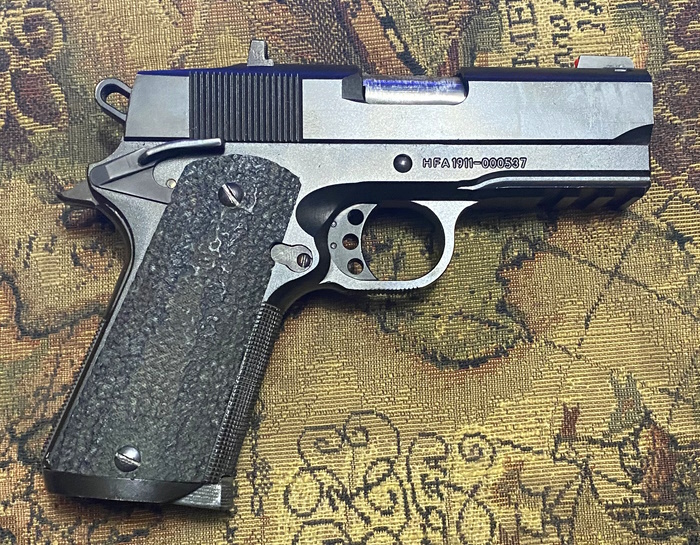Last year an instructor told me, “I’ve had well-trained people forget to remove their safety under stress.” I responded, “No, you haven’t.”
See, to my way of thinking a well-trained person will remove the safety every time they need to without thinking about it. Because training. Under stress we do what we trained to do, good, bad or indifferent. If you are going to carry a pistol with a manual safety if your forget it under stress you are not well trained by definition.
Most modern guns have a manual safety of sorts in the form of a lever on the trigger or similar arrangements that prevent the trigger from being pulled accidentally. These guns have proven overall to be as safe as any other gun, and for most firearms nothing other than basic firearms safety is required for the gun to be handled and operated safely. Glock re-introduced this feature in the Glock 17, and it has been widely adopted since (the original trigger-safeties of this type date back to revolvers from the early 1890s.)
The average owner has neither need or desire for a traditional manual safety, and that’s fine. Many modern designs do not require one other than that trigger-dingus. So why would one opt for a gun with a manual safety?
I can think of some reasons. They may have inherited and older-style gun or a gun with a safety was the best they could afford. Or the gun offers qualities and capabilities that make the manual safety worth putting up with, like superb accuracy and rapid-fire capabilities. Pretty much everyone agrees a good trigger is a huge aid to accuracy, and the best triggers are on single action semi-autos like the 1911 and 2011.
Yeah, yeah I hear people say, “My aftermarket Glock trigger is just as good.’ I think they believe that. I had a friend who was into muscle cars, and he insisted they handled corners just fine. Then he got a modern car with a sport suspension and realized those old cars did NOT actually handle corners well. He just hadn’t any experience with other cars to base his opinion on.
Of course if you grew up with Glock triggers that’s your standard for comparison. You can get a pretty darned decent trigger on a modern striker-fired pistol, and that’s perfectly OK as long as it gives you the results you desire. But I have known more than a few competitive shooters that thought their aftermarket Glock trigger was fine right up until they fired a Staccato or something similar and found it was a great deal easier to get good or even significantly better results with the 2011.
That’s fine too, but the truth is a standard modern trigger will do just fine for most people and even many competition shooters. Nobody else needs the kind of performance that a gun of that *ahem* caliber offers. But it’s not always about need, is it?
OK, we’re getting off into the weeds a bit here. The point is a manual safety works fine if you train properly to use it, and thousands of properly trained people under the stress of action-shooting competitions never forget their safety. If you think that sort of competition isn’t stressful I encourage you to try it.
Of course there are safeties and then there are safeties; some are good and easy to use and some of them, well, suck. Slide-mounted safeties that have to be flipped up for example. In my experience these are usually a pain in the butt and often difficult to use.
For myself I have been carrying a CZ P-01, and I replaced the manual safety with a de-cocker. I feel the double-action on the first pull is adequate as a safety for me. But I am soon to be replacing that with a custom 1911 variant. It’s slightly smaller than the CZ, about the same weight and holds only nine rounds instead of fifteen. So why would I take the hit in capacity and deal with a manual safety when I have the CZ?
Because we’re all individuals and I value the qualities and capabilities of the new gun over the capabilities of the very, very good CZ. I can shoot it more accurately faster than the CZ, and the training for the manual safety is a non-issue since I cut my teeth on 1911s four decades ago. For me I feel the better shooting qualities and long familiarity of the 1911-based gun outweighs the extra six rounds the CZ carries. Your mileage will absolutely vary of course and there is absolutely nothing wrong with that.

I still hear people say they would never carry a gun with a manual safety because they might forget to deactivate it. These people are genuinely better off not having one, I think. Honestly on most modern firearms they are superfluous so there’s no reason they have to or should. But thinking the very idea of a manual safety is inherently bad? Hogwash. It’s simply a matter of a well-designed safety and correct training.
Stay safe and take care,
Michael Tinker Pearce, 6 March 2023
> For me I feel the better shooting qualities and long familiarity of the 1911-based gun outweighs the extra six rounds the CZ carries.
I think that sums it up – especially familiarity.
A former co-worker pined for the perfect example of the S&W Model 15 they carried in the Air Force: more than a decade of training and duty with it was more than justifiably of greater value to them than a platform with better spec sheet performance in terms of cartridge performance, capacity, reload speed, even abuse tolerance. That manual of arms was still muscle memory to them and I completely understand the preference to rely on it.